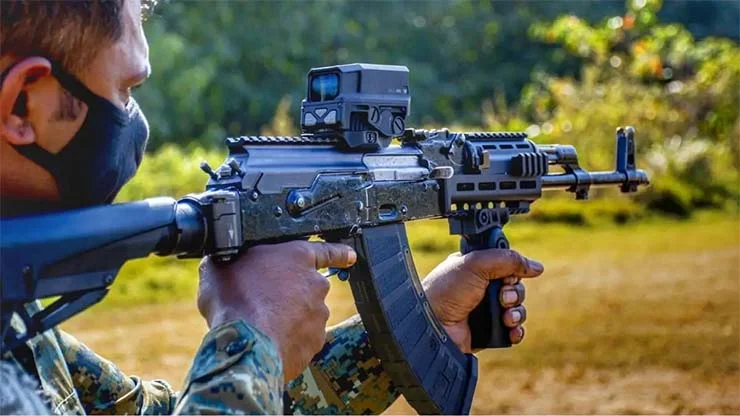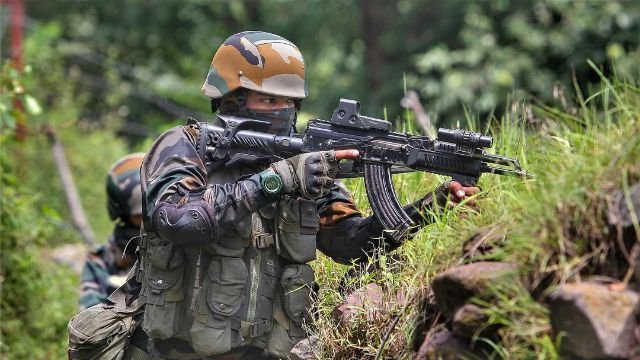By December 31, 2025, the first 100% indigenous AK-203 rifle—nicknamed Sher—crafted entirely with domestic components and manufacturing processes—is scheduled to roll off the Indo-Russian Rifles Private Limited (IRRPL) production line at Korwa, Amethi, in what is flaunted as a new milestone in India’s journey toward self-reliance in defence production.
As of September 2025, the AK-203 had achieved about 50% indigenous content, with plans to reach 70% by October and full indigenisation by December 2025. This steady climb marks the final stretch toward delivering the nation’s first fully home-grown AK-203 rifle by the end of the year, signalling a landmark achievement in India’s small arms self-reliance.
This is being hailed as a big step in India’s quest for self-reliance in small arms. According to IRRPL’s CEO and Managing Director, Maj Gen S K Sharma (Retd), this is going to be a watershed moment for the “Make in India” initiative in the defence sector.
If IRRPL meets its declared target, the following things will happen on December 31, 2025:
- India will no longer have to depend on foreign inputs for the AK-203
- Local production will insulate the Army from external supply shocks and compress delivery timelines
- The plant will deliver one rifle roughly every 100 seconds —about 12,000 rifles per month.
- The plan is to match the Army’s requirement of more than six lakh rifles by 2030.
- The self-reliant status—will be a psychological milestone and a big boost for the morale of industrial workers and soldiers alike
- Indigenous manufacture will ensure availability of spares, and mid-life upgrade, reducing long-term cost and dependency.
Shift from Near-total Dependence on Imports to Indigenous Platforms
For years, India’s infantry modernisation suffered from the gap between “assembled here” and “designed, sourced, and made here.” The result was a dependence on imported kits, fluctuating supply chains, and limited control over quality or upgrades. As a result, the Indian infantry was forced to rely on weapons and equipment based on foreign designs and imports—often outdated or mismatched to Indian conditions. For instance:
INSAS Rifles (1990s–2020s): Although technically developed in India, the INSAS family relied heavily on imported components like polymers, springs, and certain steel grades in its early years. It also had performance issues such as jamming and cracking magazines in high-altitude conditions, forcing the Army to patch up rather than replace with a modern alternative.
For years, India’s infantry modernisation suffered from the gap between “assembled here” and “designed, sourced, and made here.” The result was a dependence on imported kits, and limited control over quality or upgrades. The shift to indigenous platforms like the AK-203 will give commanders a modern, reliable rifle built for India’s unique terrain and missions
FN FAL / SLR (1950s–1990s): Before INSAS, Indian infantry used the Self-Loading Rifle based on the Belgian FN FAL design. While assembled at Ishapore, many critical components and the base design were foreign, making India dependent on overseas suppliers for spares and upgrades.
AK-47 Variants from Eastern Europe (1980s–2000s): For counter-insurgency and high-altitude operations, units often procured AK-47s and AKM rifles from former Soviet bloc countries. These were imported directly or routed through third countries, with no domestic production line or assured spare-parts support.
Modern Carbines and CQB Weapons: Even as recently as the 2010s, India issued tenders for imports like the Israeli Tavor TAR-21, SIG-716 rifles from the US, and CAR-816 carbines from the UAE. These stopgap procurements highlighted the absence of a fully indigenous, modern small-arms ecosystem.
By moving to a fully indigenous model, India is closing that gap—creating home-grown designs, certifying local vendors, and building complete production ecosystems that give the armed forces faster deliveries, better lifecycle support, and true strategic autonomy. The shift to indigenous platforms like the AK-203 will give commanders a modern, reliable rifle built at home for India’s unique terrain and missions.
What “100% Indigenous” Actually Means
“100% indigenous” means that every part of the AK-203 rifle — from its barrel and bolt to its magazines, furniture, coatings, and fire-control components — is designed, sourced, and manufactured within India rather than being imported or assembled from foreign kits. This involves Indian raw materials, local vendors, domestic machining and heat-treatment processes, Indian-made testing and proofing systems, and complete quality control within the country. In practice, it signifies full self-reliance and sovereignty over production, spares, and future upgrades, reducing costs, shortening delivery times, and ensuring security of supply for the armed forces.

The AK-203 project began with progressive indigenisation: early lots were assembled from imported kits, then moved to higher local content as supply chains matured and tooling came online. Officials have signalled that “every material now has an alternate source in India,” a strong indicator that the last dependencies on imported inputs are being closed.
The Rifle, the Factory, and the Scale-up
The AK-203 programme flows from an inter-governmental agreement with Russia and a joint-venture structure in which Indian public-sector firms AWEIL and MIL hold 50.5%, while Russia’s Rosoboronexport and Concern Kalashnikov hold 49.5%. The overall order falls under an Rs 5,200-crore framework to supply over six lakh rifles and establish a manufacturing base in India. The intent is not only to equip the Army quickly but also to build sovereign capacity in small-arms manufacturing.
“100% indigenous” means that every part of the AK-203 rifle — from its barrel to bolt, magazine, and fire-control components — is designed, sourced, and manufactured within India rather than being imported or assembled from foreign kits reducing costs, shortening delivery time lapse, and ensuring uninterrupted supply for the armed forces
The AK-203 is a 7.62×39 mm, modernised Kalashnikov-pattern rifle engineered for reliability, improved ergonomics, and ease of maintenance. It is set to replace the long-serving INSAS family. Licensed production began at IRRPL’s Korwa facility in January 2023.
Once fully indigenised, IRRPL targets a time of roughly one rifle every 100 seconds—about 12,000 per month—rising to an annual output of around 1.5 lakh (150,000). This volume, underpinned by domestic supply chains, is designed to accelerate fielding while strengthening India’s self-reliance in small arms.
Why it Matters for the Soldier
At the section and platoon level, moving to a robust 7.62×39 mm platform increases terminal effect and improves reliability—especially in high-altitude and counter-terrorism operations where simplicity and tolerance to harsh conditions are critical. The AK-203 fuses proven Kalashnikov genetics with modern rails, better ergonomics, and tighter manufacturing tolerances. The gains go beyond lethality: common training, interoperable accessories, and easier maintenance reduce friction across formations. As it replaces legacy INSAS rifles, multiple field reports have underscored the AK-203’s fit with India’s terrain and operational profile—delivering a rifle that’s tougher in the elements and simpler to keep in the fight.
Exports: A Future Payoff
IRRPL leaders have spoken about export ambitions once the domestic line is steady and fully indigenised. While the near-term focus remains fulfilling the Army’s order book, the combination of competitive cost, local supply chains, and a globally recognised design could open markets in Asia, Africa, and Latin America—especially for forces already trained on Kalashnikov platforms. Business press coverage and executive briefings have hinted at exploring exports as the next logical step once “Sher” status is achieved.
Conclusion
The journey from dependence to self-reliance in small arms marks a turning point for India’s defence preparedness. The country is not just equipping its soldiers with a modern and reliable weapon but also building a domestic ecosystem for critical defence manufacturing. This milestone underscores India’s ability to design, source, and produce world-class equipment at home—reducing vulnerability to global supply shocks, lowering costs, and setting the stage for future exports. In essence, the AK-203 project represents more than a rifle; it’s a symbol of India’s rising technological confidence and a template for how Make in India can transform national security.
–The writer is a seasoned media professional with over three decades of experience in print, electronic, and web media. He is presently Editor of Taazakhabar News. The views expressed are of the writer and do not necessarily reflect the views of Raksha Anirveda






